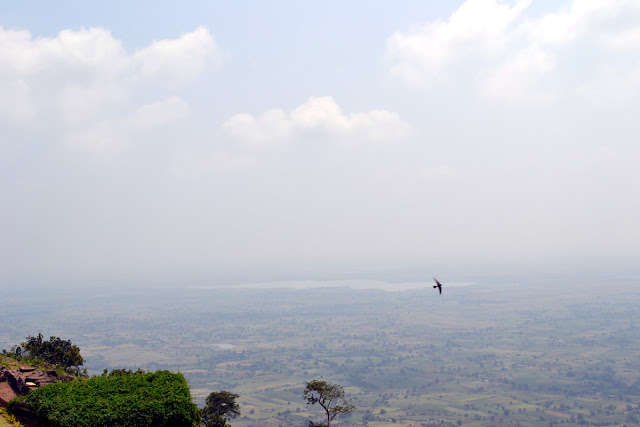Mandu mesmerises you. Especially if you are there after monsoon. Like we were.
We visited Mandu as a part of 15 days long road trip in central India. We stayed in lovely Jhira Bagh palace in Dhar. The palace being on the highway and on the outskirts of Dhar helped. We did not have to go through the town. The road from palace to Mandu was surprisingly good as this must be the route taken by most tourists coming from Indore.
After fifteen KMs we see a sort of picnic spot with some locals. We could see a huge gorge. We ask the local guy and he says it is called “SUSIDE POINT”. We get down to see what it is all about. I get zapped to see fantastic valley and a nice waterfall. Brinda gets out of the car and get her Nikon. The valley looks beautiful and the gorge really deep. There wasn't much of water in falls – must be a beautiful sight when it rains – but still looked charming. We can now understand why the locals call this SUSIDE POINT!!
 |
| Valley view @ Suside point |
 |
| Beautiful Waterfalls @ Suside point |
Mandu or MANDAVA as it was known in medieval times was the largest fortified city in the country. Mandu is a huge, crumbling collection of old buildings from the 15th and 16th centuries, sitting on top of a large, flat mountain, surrounded on all sides by steep sloping sides and rugged hairpin roads. It is steeped in atmosphere and history. Poorna had gone there after rains in year 1986 while posted in MHOW. Mandu is magical after rains. Greenery is soothing and with broken fort walls ,gates and palaces thrown in between it gives a magical look.
Without giving too much of history – which one can get from Wiki – the place today is well preserved by Archaeological survey of India. In fact ASI has published an excellent monograph on the place. One can comfortably spend a day exploring the various monuments in the place. The place still retains its rustic rural charm and is not crowded unlike many of our monuments.
 |
| One of the Gates to Mandu |
We take a guide as soon as we reach the town. Though the town is well signed, we always feel it is good to have a guide with you so that do don’t have to struggle for directions. Also important is to set expectation clear to guides how much time you can spare to see the place. Guides are garrulous and we need to keep a check on them.
Our first stop is at the Echo point. There are two buildings opposite to each other very far from the road at the edge of the hill. Echo Point is named so because, situated next to a steep hill, the scenic place gets this name from the natural echo phenomenon here.
 |
| Echo Point |
You stand on the road at a designated point and shout and it gets echoed in it building on the right!! We shout and it works….like the way it does in Golconda in Bijapur. More than the echo part, we loved the setting of these mausoleums in the middle of greenery.
We drive along the road watching many ruins at a distance. Then we see the vast expanse of water set amidst greenery – Sagar Talab. The good monsoon has filled the tank to the brim. It looks lovely and the tank is also used for boating and we could see some honeymooning couples paddling away in the waters!!
 |
| Sagar Talab |
Roopmati pavilion look imposing from a distance. Built on the highest point of Mandu, with "Open to sky cupolas" it has excellent views of the valley in all directions. Rani Roopmati, the consort of Baz Bahadur lived here and balladeers of Malwa have many stories of romance between them. It is a simple construction with cupolas in the corners.
 |
| Roopmati Pavilion from Distance |
 |
| Eastern elevation - Roppmati Pavillion |
 |
| Baz Bahadur Palace as seen from the top of Roopmati Pavilion - Notice the greenery around |
 |
| Archway - Roopmati Pavilion |
 |
| Rainwater Harvesting techniques - Roopmati Pavilion |







































0 comments:
Post a Comment